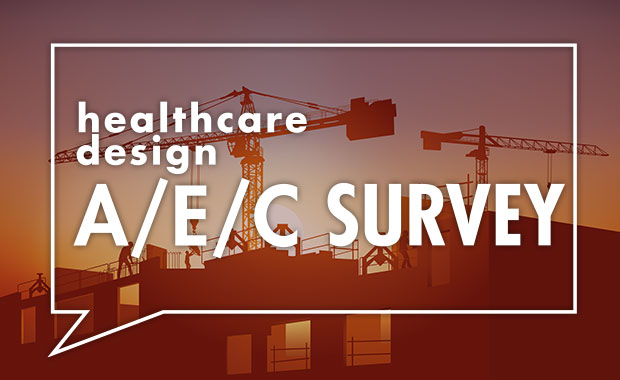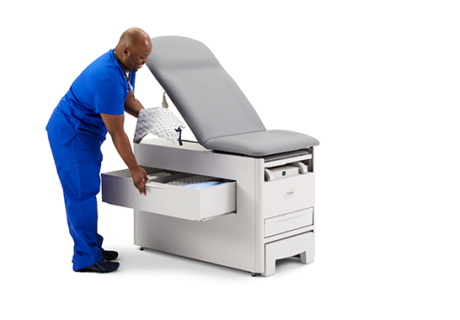2022 Healthcare Design A/E/C Survey Results
2022 A/E/C Survey shows industry rebound
While the devastating impact that COVID-19 has had on the U.S. healthcare system is clear, reverberations were felt throughout the healthcare design industry, as well.
Healthcare architecture/engineering/construction (A/E/C) firms made their way through a 2020 defined by emergency response efforts as providers grappled with surging patient volumes as well as uncertainty tied to the long-term building project outlook due to sinking healthcare revenues.
However, even as the pandemic continued its course into 2021, a rebound was underway—and a robust one—as indicated by the results of the 2022 Healthcare Design A/E/C Survey.
Key findings highlight growth across projects completed, requests for proposals (RFPs) received, and contracts signed in 2021 compared to 2020. But it’s growth that’s clearly driven by where we’ve been, with projects guided by issues that have emerged throughout the crisis such as achieving flexibility/adaptability, growing revenue, and improving population health and care access.
Yet this rapid escalation in projects isn’t coming without its challenges, as firms share that project team sizes aren’t growing at the rate of project volume, meaning talent acquisition and retention remain key to moving forward. Meanwhile, issues plaguing the building industry broadly are influencing healthcare, including those tied to material availability, labor shortages, and cost inflation.
The 2022 survey was conducted online in January and February. It was open to any U.S. A/E/C firm that completed at least one healthcare project in the prior year; all financial and business data reported is from 2021. Of the responding companies, 81 percent were architecture firms, 15 percent construction firms, and 4 percent engineering.
In total, healthcare represents 46 percent of the participating firms’ overall business; 36 percent of respondents reported healthcare as their primary sector, comprising 60 percent or more of their work.
(To view this article with corresponding charts, please see the digital edition.)
Healthcare design projects, RFPs, and revenue
Survey respondents reported a total of 3,726 projects completed in 2021, and 45 percent of firms said the number they completed in 2021 was more than it was in 2020. Additionally, 36 percent said they saw about the same number and just 19 percent reported fewer. Comparatively, in the last A/E/C Survey (which was conducted in 2020 and assessed 2019 business results), 39 percent of firms reported completing more projects compared to 2018 and 46 percent about the same.
Meanwhile, RFPs received in 2021 skyrocketed over 2020 levels, with 60 percent of firms reporting receiving more year over year, as 21 percent said they received about the same and 19 percent fewer. In sum, the survey respondents reported receiving 5,752 RFPs last year. In 2019, 43 percent of firms said they had more than in the previous year, while 40 percent saw about the same and 17 percent fewer.
A total of 5,114 new healthcare contracts were reported signed in 2021 and valued at $25.9 billion; of those, 63 percent were for architectural services, 16 percent engineering, and 21 percent construction. Fifty-two percent of respondents said they saw a year-over-year increase in contracts signed compared to 2020, while 27 percent said theirs were about the same and 21 percent said they had fewer. Compared to 2019, just 32 percent at the time had signed more healthcare contracts than the prior year, 41 percent about the same, and 27 percent fewer.
Together, the responding A/E/C firms reported a combined $11.3 billion in healthcare revenue generated in 2021. Of that, 67 percent was for architectural services, 15 percent engineering, and 18 percent construction. And as the year closed, a reported 6,946 projects remained in progress, with 3,039 scheduled for completion in 2022.
What are the most common types of healthcare projects?
Of the projects completed by responding firms in 2021, 60 percent were renovations versus 40 percent new construction. This represents a significant jump in renovations from 2019, when completed projects were split between 49 percent renovations and 51 percent new construction. Specifically, hospitals comprised 52 percent of projects completed and outpatient/ambulatory 36 percent, while skilled nursing/rehabilitation and infrastructure-only projects comprised just 6 percent each—all nearly mirroring results from 2019.
Completed projects primarily skewed smaller, as more than half of those reported (55 percent) fell into the smallest size range of 5,000-19,999 square feet. Next closest was 20,000-49,999 square feet with 20 percent and 50,000-99,999 square feet at 12 percent. Although projects in 2019 followed the same pattern, they were more distributed across the ranges—for example, in 2019, 37 percent were 5,000-19,999 square feet, 23 percent 20,000-49,999 square feet, and 20 percent 50,000-99,999 square feet.
Project values in 2021 showed similar results, as well, with most reported on the lower end of the scale. Of completed projects, 33 percent fell in the smallest range of less than $500,000, followed by 29 percent valued at $1 million-$9.9 million (values are construction costs excluding land). Next highest was $500,000-$999,000 with 16 percent of projects, while a combined 22 percent fell across remaining values of $10 million and above.
In 2019, the most common value range was $1 million-$9.9 million, representing 28 percent of that year’s completed projects, followed by less than $500,000 at 20 percent; in that survey, a total of 34 percent of projects spanned ranges $10 million and up.
To capture the drivers behind recent healthcare work, responding firms also were asked to identify most common client goals and needs. There was a near-tie for top client need in 2021, with renovation/modernization of space chosen by 26 percent of firms and expansion of/addition to an existing facility selected by 23 percent.
Growth of outpatient sites, replacement of outdated buildings, and repurposing space for new use were each chosen by 14 percent of respondents, as renovation work with addition was chosen by 9 percent. These top needs were similar to those reported for 2019, with the most popular at the time being renovation/modernization of space, replacement of outdated buildings, and expansion of/addition to an existing facility.
Next, respondents identified the most common client goal shaping new projects last year. For 2021, the top goals selected were achieving future flexibility/adaptability at 27 percent and growing revenue and supporting population health/improving access to care both at 23 percent. The other top choice was improving patient experience/satisfaction at 18 percent.
Comparatively, in 2019, improving patient experience/satisfaction led results (40 percent), followed by designing for future flexibility/adaptability (35 percent) and supporting population health (18 percent). The answer of growing revenue was not an option in the 2020 survey.
Healthcare design business outlook
In open-ended responses, firms had the opportunity to weigh in on healthcare design business today, with one near-constant answer being that business is booming—but there are pros and cons coming with it.
One source of that surge in work is academic medical centers experiencing growing demand for tertiary and quaternary care, requiring specialty spaces to be carved out of existing campuses, said respondent Donald Blair, senior principal at Blair + Mui Dowd Architects (New York). This change is inspiring a shift to placing outpatient services off campus and relocating nonacute inpatient clinical services to community hospitals. The result is lots of projects, including space conversions and modernizing outdated facilities.
“The demand for new construction and major renovation projects has led to major opportunities for healthcare architecture firms, with an increasing backlog of significant projects,” he said.
Mike Pukszta, co-director, global health practice at CannonDesign (St. Louis), similarly noted that numerous hospitals and healthcare systems are investing “significant sums of money on capital projects” and that the scale of projects is starting to increase with that volume of work. But time is a major factor, as well. “Because of the low cost of money and increasing construction and labor escalation, there’s also a strong desire expressed by many hospital leaders to accelerate the design-to-groundbreaking timeline to take advantage of lower interest rates while mitigating the impact of escalation,” he said.
In fact, cost escalation, material availability, and labor shortages are all significant barriers on the healthcare construction landscape, especially. “We work collaboratively with our healthcare clients and design team partners to find mitigation strategies for challenges. These include design alternatives, supplier relationship management, agreements with key suppliers, manufacturers’ quality assurance through due diligence, and centralized material logistics,” said respondent Hamilton Espinosa, healthcare core market leader at DPR Construction (Phoenix), adding that another major opportunity is the enhanced use of prefabrication.
Meanwhile, as project work rapidly grows, firms across the A/E/C community reported that they face limited staff resources to absorb it. “While we have grown as a practice, the service need appears to be escalating faster than our firm, and many others, can meet,” said Laura Stillman, national healthcare practice leader at Flad Architects (Madison, Wis.). “We have always valued our legacy clients and will serve them first. So in taking on new clients, we have had to be extremely selective.”
Retention and mentorship in the current work environment is a growing problem, as well, Blair noted. “Healthcare design is a segment of the architecture profession where in-person mentoring, experience, and especially collaboration are essential features in attracting and training staff. … Although remote work or a hybrid form improves employee flexibility, mentoring and training is significantly more challenging in the virtual environment,” he said.
Despite the challenges of navigating this flood of business today, the pandemic has ushered in a new era of healthcare—and design needs. One is addressing health equity and access to care. “We see opportunities to innovate and challenge the status quo given what we’ve learned over the last two years. We see our clients prioritizing environmental, social, and governance policies and looking to their facilities and real estate assets to help address critical health equity issues in their communities,” said Paul Strohm, director of healthcare at HOK (St. Louis).
Similarly, Hank Adams, global health director at HDR (Dallas), noted that “with population health strategies in place to get upstream of the social determinants of health, ambulatory care will be an opportunity to address the specific needs of each community within a health system’s reach.”
Another way the pandemic is inspiring future projects is in investment in solutions to prepare for a similar crisis. “The entire industry and all building types will need to focus on infectious disease preparedness, increasing the capacity for biocontainment units and strategies. Updating current facilities and designing new facilities to be adaptable and flexible to handle surge in a pandemic situation must be top of mind for everyone involved in healthcare,” Adams said.
Wellness, too, has emerged as a top-of-mind topic influencing projects, with AE Works (Arlington, Va.) noting the trend as an opportunity to introduce solutions ranging from biophilic interiors to increased air filtration and outdoor air, said Sara Lappanno, vice president of operations.
Adding in sustainability, carbon neutrality, and high-performance buildings, among the other trends mentioned, Joshua A. Theodore, vice president, global health at Leo A Daly (Dallas), asserted optimism for what’s to come. “The influx of new projects has been very exciting for our teams,” he said. “The next generation of health facilities is going to be the best customer-and client-focused, data-driven, research-informed buildings we have ever produced.”
Jennifer Kovacs Silvis is editor-in-chief of Healthcare Design. She can be reached at jennifer.silvis@emeraldx.com.



